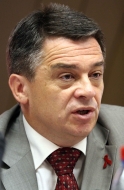- Serbia
Get to know Serbia
- Citizens
Culture and science
Health services
Pension and disability insurance
- Business
Employment
Economy
- Media
- Government
- Contact
Keep in touch
Contact form
Back
Keepin touch
Whether you have a question, comment, suggestion or any problem in the purview of the government, send us your message and we will try to respond as soon as possible. If your problem is not in our purview, we will forward your message to the relevant institution.
Q:
A:
Results of HIV incidence research presented
Belgrade,
28 July 2008
Serbian Minister of Health Tomica Milosavljevic has said that results of the research on HIV incidence and risky behaviour show that the disease is found not only among high risk groups but also individuals who engage in risky behaviour.
Speaking at a press conference held at the Serbian Institute of Public Health “Dr Milan Jovanovic Batut”, Milosavljevic said that a project to fight HIV which is being implemented with the financial help of the Global Fund and supported by the Serbian public health institute and UNICEF has produced good results.
Serbia is implementing a national plan for monitoring a unified response to the HIV epidemic threat and is precisely following the national strategy for the fight against HIV/AIDS with the support of the National Office for HIV/AIDS, said the Minister and added that the research undertaken was just part of the aforementioned project and will be carried out again in 2009 and 2011.
According to Milosavljevic, capacities for care and treatment of individuals living with HIV in Novi Sad, Nis and Kragujevac have been increased, and the HIV ward at the clinic for infectious diseases in Belgrade has been renovated at a cost of nearly €30,000.
Highly active antiretroviral therapy (HAART) has been provided, financed with funds from the Serbian Health Insurance Institute, which means that treatment costs for those who have already developed symptoms are completely covered, explained Milosavljevic.
He said that funds for this purpose stood at €2.3 million in 2006, and last year the sum was €3 million.
The Minister said that Serbia has not been spared this dangerous disease which is a global problem for mankind, and added that the number of children without parents suffering from AIDS or infected with HIV is in the millions.
Research on HIV incidence and risky behaviour among high-risk groups was first carried out in Serbia in the period from November 2007 to May 2008, but the picture will not be complete until results of two more rounds of research in 2009 and 2011 become available.
The research included intravenous drug users, sex workers, homosexual males, young Roma individuals, children living in institutions, prisoners and those living with HIV, a total of 3,778 subjects.
The basic purpose of the research is to determine the frequency of risky behaviour in order to better monitor epidemiological impact and to improve existing health programmes.
Serbia is implementing a national plan for monitoring a unified response to the HIV epidemic threat and is precisely following the national strategy for the fight against HIV/AIDS with the support of the National Office for HIV/AIDS, said the Minister and added that the research undertaken was just part of the aforementioned project and will be carried out again in 2009 and 2011.
According to Milosavljevic, capacities for care and treatment of individuals living with HIV in Novi Sad, Nis and Kragujevac have been increased, and the HIV ward at the clinic for infectious diseases in Belgrade has been renovated at a cost of nearly €30,000.
Highly active antiretroviral therapy (HAART) has been provided, financed with funds from the Serbian Health Insurance Institute, which means that treatment costs for those who have already developed symptoms are completely covered, explained Milosavljevic.
He said that funds for this purpose stood at €2.3 million in 2006, and last year the sum was €3 million.
The Minister said that Serbia has not been spared this dangerous disease which is a global problem for mankind, and added that the number of children without parents suffering from AIDS or infected with HIV is in the millions.
Research on HIV incidence and risky behaviour among high-risk groups was first carried out in Serbia in the period from November 2007 to May 2008, but the picture will not be complete until results of two more rounds of research in 2009 and 2011 become available.
The research included intravenous drug users, sex workers, homosexual males, young Roma individuals, children living in institutions, prisoners and those living with HIV, a total of 3,778 subjects.
The basic purpose of the research is to determine the frequency of risky behaviour in order to better monitor epidemiological impact and to improve existing health programmes.
-
 Belgrade, 22 January 2025
Belgrade, 22 January 2025Egypt one of Serbia’s closest partners on international stage
-
 Belgrade, 9 July 2024
Belgrade, 9 July 2024Support for 104 associations in diaspora that preserve Serbian language, culture
-
 Belgrade, 15 April 2024
Belgrade, 15 April 2024Competition for StarTech grants open until 31 May
-
 Belgrade, 2 October 2023
Belgrade, 2 October 2023Serbia respects Resolution 1244 and will do everything to preserve peace
-
 Belgrade, 13 September 2023
Belgrade, 13 September 2023Day of Serbian Unity to be celebrated outside borders of Serbia, Republika Srpska for the first time
-
 Belgrade, 8 August 2023
Belgrade, 8 August 2023RSD 24.2m in state aid paid out to citizens affected by storm
-
 Belgrade, 17 June 2023
Belgrade, 17 June 2023Belgrade is doing everything to preserve peace in Kosovo and Metohija
-
 Belgrade, 15 June 2023
Belgrade, 15 June 2023Slovenia will continue to support Serbia on its way to EU
-
 Belgrade, 5 May 2023
Belgrade, 5 May 2023Emergency measures, tightening of conditions for possessing weapons
-
 Belgrade, 3 May 2023
Belgrade, 3 May 2023Three days of mourning in Serbia over tragedy at Vladislav Ribnikar primary school

